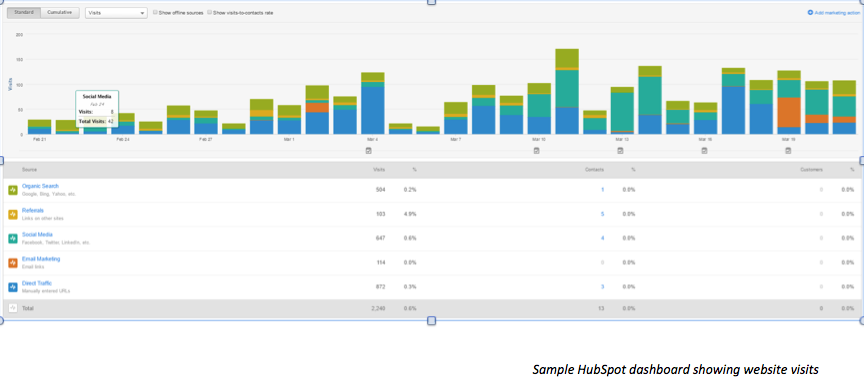We were introduced to HubSpot two years ago and immediately found it a very effective and efficient Inbound Marketing platform to build on our business growth strategies. In this blog I thought I would share with you why it works so well. Whether you are looking for better lead generation or social marketing, maybe our experience can help you chose your inbound marketing platform wisely.
Here are the two main reasons it works so well:
- It is an excellent dashboard providing clear, insightful information in a ready to use fashion.
- Second, It is a strategic platform that enables us to clearly convert strategy into execution to grow our leads and business.
Let’s start with the data
We found it to be a highly valuable analytic tool. We are data junkies. When explaining its advantages, we describe it this way:
“This platform provides us with instant data which becomes the kind marketing information you need to run your business. This information, as well as the platform itself, is the foundation of a highly efficient Inbound Marketing program and customer retention strategy. The result? Increased demand, lead generation and serious business growth.”
What is so powerful about instant data?
I have always been a data junkie. When I was running a large middle market company, the first thing I did in the morning was go into the order department and look at orders that had come in overnight. Having a pulse on your revenue stream, I believe, is critical to running any business and allows for rapid responses to the external business environment and your own marketing efforts.
Now when I look at a HubSpot dashboard, I can see website visits, leads and customers. This is akin to looking at a daily sales report. You begin to see trends. And understanding these trends is always critical to running a business.
These tools enable you to develop and execute better strategies
It’s all about how to grow your business efficiently. Part of this is doing the right thing the first time. Understanding the data from all the various HubSpot reports (the Dashboard) easily and powerfully allows us to do that. But there is a second part of efficiency — what I call physical efficiency. It is the ease with which we can use the HubSpot tools to produce better content, and then distribute it across our blogs, emails and social marketing channels. This is directly tied into our growth strategy and how well we can execute upon it. You will find it a core part of your business thinking as we do.
So if you buy into the above, this is where the rubber meets the road. In business, there always appears to be a disconnect between the intellectual “efficiency” and the “dollar” efficiency. How do I assign a value to what is being done now vs. what we are recommending for the future? How do I take soft dollar costs and compare these to hard dollar outlays?
HubSpot recently published some data by one of its Inbound partners, OverGoStudio.com. Starting with lost opportunity, what is the value of a person whom you bring onto your site and then shepherd along the buyer’s journey? And how do you balance that against the cost of HubSpot — because whether you are a basic, professional or an enterprise subscriber, there is a cost.
According to OverGoStudio.com, “Free is an attractive price. But since there is no free tool that can support all your marketing efforts, you have to acquire and coordinate a variety of independent Marketing production and analytic tools.” So, what do you do?
The answer: You need to go through a P and L analysis. What is the return on investment of a HubSpot or any inbound marketing platform? And while I do not have all the numbers, let’s look at the information that OverGoStudios.com published.
They approached 14 companies and accounting for all the variables, tried to determine if they could answer the question, Is HubSpot worth the investment? They decided that the creative content, in terms of quality of the blogs, was similar for a 12-month period. Then they separated companies into two groups: those that used HubSpot and those that didn’t. Each group had an equal number of B2B and B2C companies.
OverGoStudio.com found some very interesting results.
- Those clients using HubSpot had a 590% growth rate.
- Those that did not? Only 170%.
Even without knowing the gross margins of any of these 14 companies, it would still stand to reason that a growth rate of more than triple the amount would justify the dollar expenditure for HubSpot. And, the efficiency generated by using this platform even better justifies the use of it. (Remember: hard and soft dollars.)
An investment that pays off exponentially
We can also look at this investment another way. Yes, HubSpot is not inexpensive and yes, it requires an investment in manpower to take advantage of this powerful tool. So what do we say to clients when we put together a proposal that could cause sticker shock?
- The keyword analysis report allows you to both understand where you rank on keywords and where to “heavy up” to move your page ranking forward. This helps in conversion opportunities, long tail opportunities and understanding where you are with respect to competitors.
- The HubSpot publishing tools allow for effective keyword placement in all your content and for effective calls-to-action.
- Everything is in one place with HubSpot. All CRM, lead generation and publishing activities can be managed much more efficiently and, in effect, the dashboard becomes a critical part of your overall marketing and business development process. Looking at all the different facets of a HubSpot platform each morning has real benefits.
- Finally, the multi-faceted publishing capabilities of content on your website, from blogs to social marketing, is extremely efficient and leads to creative business ideas you might not have thought of otherwise.
To me, to shift to the HubSpot platform is not a leap of faith but rather a smart business decision, reinforced by our own experiences with it as well as the research that Overgostudios.com found.
What do you think? Is Inbound Marketing something that your business needs to grow?
To read more download our white paper on “The Inbound Methodology.“
If you would like to discuss further, please contact me at 914-245-1641.

Andy Simon, Partner
Simon Associates Management Consultants




